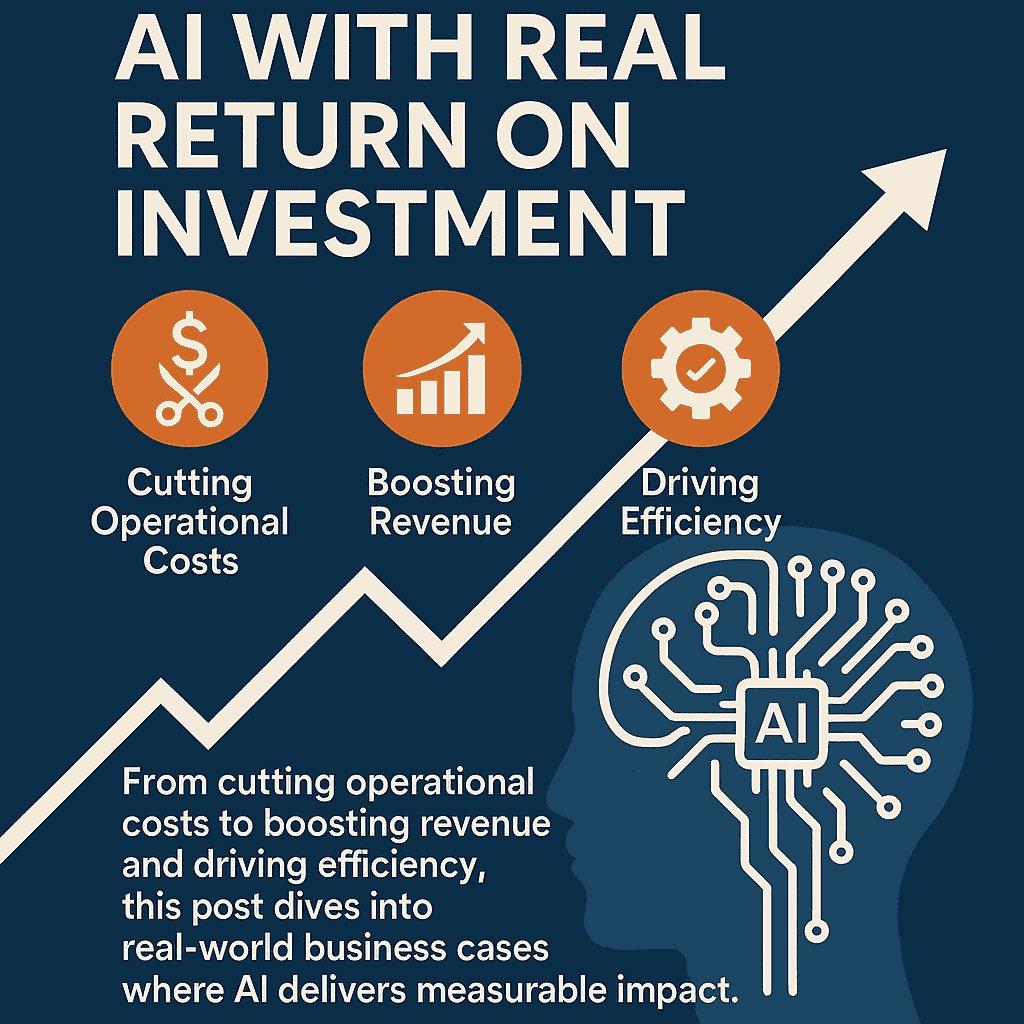Beyond Buzzwords: AI’s ROI with Real Business Cases

The AI automation era is in full swing, but businesses are no longer satisfied with just hype and buzzwords. While terms like “game changer” and “disruptive” flood conversations, decision-makers are asking a more important question: What’s the real return on investment? It’s not enough to speculate on AI’s potential—we need to showcase tangible results. From cutting operational costs to boosting revenue and driving efficiency, this post dives into real-world business cases where AI delivers measurable impact.
The ROI Reality Check: Well Beyond Speculation
Many businesses dive into AI with sky-high expectations, often fueled by media buzz and bold predictions. But without a clear roadmap to measurable outcomes, AI investments risk turning into expensive experiments. Success comes from moving beyond speculation and grounding AI initiatives in real-world performance metrics. Organizations that thrive with AI aren’t just exploring possibilities—they’re tracking cost reductions, revenue increases, and operational improvements with precision. By focusing on data-driven insights and strategic implementation, businesses can transform AI from an abstract concept into a powerful driver of efficiency and profitability. The key lies in shifting from a “potential” mindset to a “performance” mindset, focusing on specific, measurable results.
Side note: The popularity of Workflow Automation Tools combined with AI are making some incredibly interesting use cases that produce *significant* time savings and ROI — More on a blog post coming soon | See: Real-World Applications of Artificial Intelligence: Documented Uses Across Industries.
Blog post with more use cases See: Real-World Applications of Artificial Intelligence: Documented Uses Across Industries – Check it out!
Multiplier Effects: More Than Just Direct Savings
It’s crucial to understand that AI’s ROI often extends beyond direct cost reductions or revenue increases. Think of it as a ripple effect:

- Enhanced Productivity: AI automates repetitive tasks, freeing up human employees for higher-value activities. This not only saves time but also boosts morale and reduces burnout.
- Improved Decision-Making: AI-powered analytics provide deeper insights, enabling businesses to make more informed and strategic decisions. This can lead to better resource allocation, reduced risks, and increased profitability.
- Enhanced Customer Experience: AI-driven personalization and customer service can significantly improve customer satisfaction and loyalty, leading to increased customer lifetime value.
- Operational Efficiency: AI can optimize complex processes, reducing errors, minimizing waste, and streamlining workflows.
These multiplier effects compound over time, transforming initial ROI into significant, long-term gains.
The Importance of Data, Framework, Phased Approach and Continuous Improvement
To realize the full potential of AI ROI, businesses must invest in robust data infrastructure and ensure data quality. AI algorithms are only as good as the data they’re trained on. Without clean, accurate, and relevant data, AI initiatives can quickly become ineffective. Implementing AI is not an overnight process. A phased approach is crucial, starting with pilot projects that address specific business challenges and demonstrate clear ROI. This allows organizations to learn and adapt, building a solid foundation for future AI initiatives. The AI landscape is constantly evolving, with new technologies and applications emerging regularly. Businesses that embrace a culture of continuous improvement and experimentation will be best positioned to maximize their AI ROI and stay ahead of the competition.
Bottom line:
The AI automation era presents immense opportunities for businesses to drive efficiency, growth, and innovation. By focusing on tangible results and understanding the multiplier effects of AI, organizations can move beyond the hype and unlock the true potential of this transformative technology. It is not about the buzzwords, it is about real, measurable results. It is about understanding the data and implementing in a strategic way. The AI automation era is here, and businesses must adapt to thrive.
Real Numbers That Reveal the True Impact: Business Cases
With the help of AI (funny, as it saved me a ton of time!) I found some documented specific business cases that illustrate the tangible ROI of AI:
Table: AI ROI Use Cases with Supporting Links
| Use Case Problem | Solution | Results (Savings, Growth, Time) | Supporting Resources |
| Customer Service Bottlenecks | AI-powered chatbots and virtual assistants that handle routine inquiries, provide instant support, and escalate complex issues to human agents. | 30% reduction in customer support ticket resolution time, 25% decrease in support costs, and a 15% increase in customer satisfaction scores. This also frees up human agents to handle more complex issues. | Conversational AI ROI , AI in Customer service |
| Supply Chain Inefficiencies | AI-driven predictive analytics that forecast demand, optimize inventory levels, and identify potential disruptions. | 20% reduction in inventory holding costs, 15% reduction in stockouts, and a 10% improvement in on-time delivery rates. This prevents lost sales and optimizes cash flow. | AI in Supply chain |
| Fraud Detection in Finance | AI-powered anomaly detection systems that analyze transaction patterns and identify suspicious activities in real-time. | 40% reduction in fraud losses, 50% faster fraud detection, and improved compliance with regulatory requirements. This protects the company and its customers from financial harm. | AI in Financial services |
| Personalized Marketing Campaigns | AI-driven personalization engines that analyze customer data and deliver targeted marketing messages across multiple channels. | 25% increase in click-through rates, 20% increase in conversion rates, and 18% increase in customer lifetime value. This improves marketing efficiency and drives revenue growth. | AI for Marketing |
| Document Processing Automation | AI-powered optical character recognition (OCR) and natural language processing (NLP) to automate the extraction and processing of data from documents. | 60% reduction in manual data entry time, 35% reduction in processing errors, and improved data accuracy. This saves significant time and reduces operational costs. | Ai for workflow automation |
| Quality Control in Manufacturing | AI-powered computer vision systems that automate visual inspections and identify defects in real-time. | 30% reduction in product defects, 20% reduction in rework costs, and improved product quality. This enhances customer satisfaction and reduces manufacturing costs. | AI in Manufacturing |
| Optimizing Energy Consumption | AI systems that analyze energy usage patterns and automatically adjust building systems to minimize consumption. | 15% reduction in energy costs, and reduced carbon footprint. This creates both financial and environmental benefits. Information regarding Ai and energy consumption ROI is spread across many industry papers, and vendor publications relating to smart building technologies. finding a central general article providing precise ROI numbers is difficult. | |
| Talent Acquisition Improvement | AI-driven systems that screen resumes, schedule interviews, and identify top candidates. | 40% time reduction in filling open positions, 20% reduction in cost per hire, and improved quality of new hires. | AI in Recruitment |
If we look at it slightly different angle, from the business use case side:
| Use Case Problem | Solution | Results (Savings, Growth, Time) | Supporting Resources |
| Multinational organization facing challenges in scaling recruitment processes, high application volumes, lengthy hiring cycles, and need for diversity. | Implemented Eightfold’s AI-driven recruitment platform (automated screening, matching, scheduling, and bias reduction). | Reduced time-to-hire, decreased hiring cycle times, lowered recruitment costs, and increased representation of women and underrepresented minorities. AI automation streamlines recruitment, reducing costs and improving diversity. | Practical AI Case Studies with ROI: Real-World Insights – Leanware |
| Businesses seeking to enhance employee productivity and streamline workflows. | Implementation of Microsoft 365 Copilot and Azure OpenAI Service. | Significant time savings on routine tasks, increased code development efficiency, and faster creation of documents and presentations. Generative AI provides real and documentable productivity gains in various business sectors. | How real-world businesses are transforming with AI — with more than 140 new stories |
| Banks and financial institutions needing to reduce fraud losses and improve detection rates. | AI-powered anomaly detection systems that analyze transaction patterns in real-time. | Substantial reductions in fraud losses, faster fraud detection, and improved compliance. AI significantly strengthens fraud prevention, protecting businesses and customers. | AI in Financial services |
If you need help with the use of AI, automating your workflows, increasing your productivity and making you your life easier, send me a note
